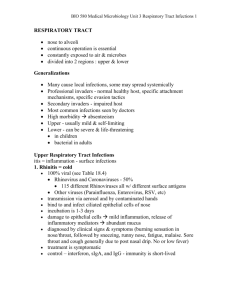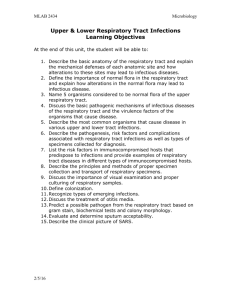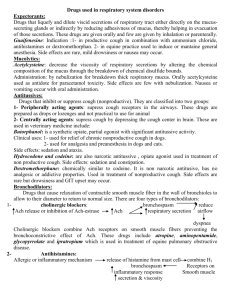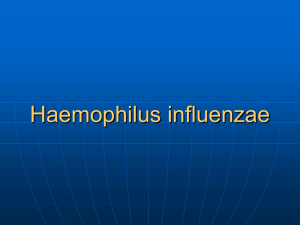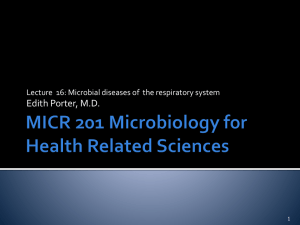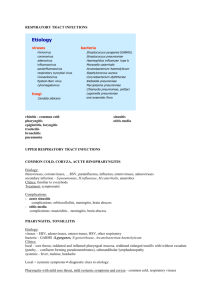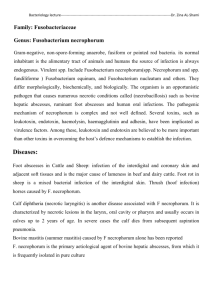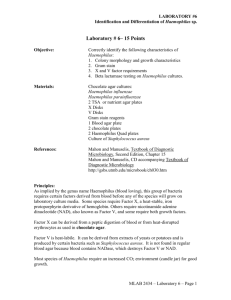Chronic Respiratory Infections - PBL-J-2015
advertisement
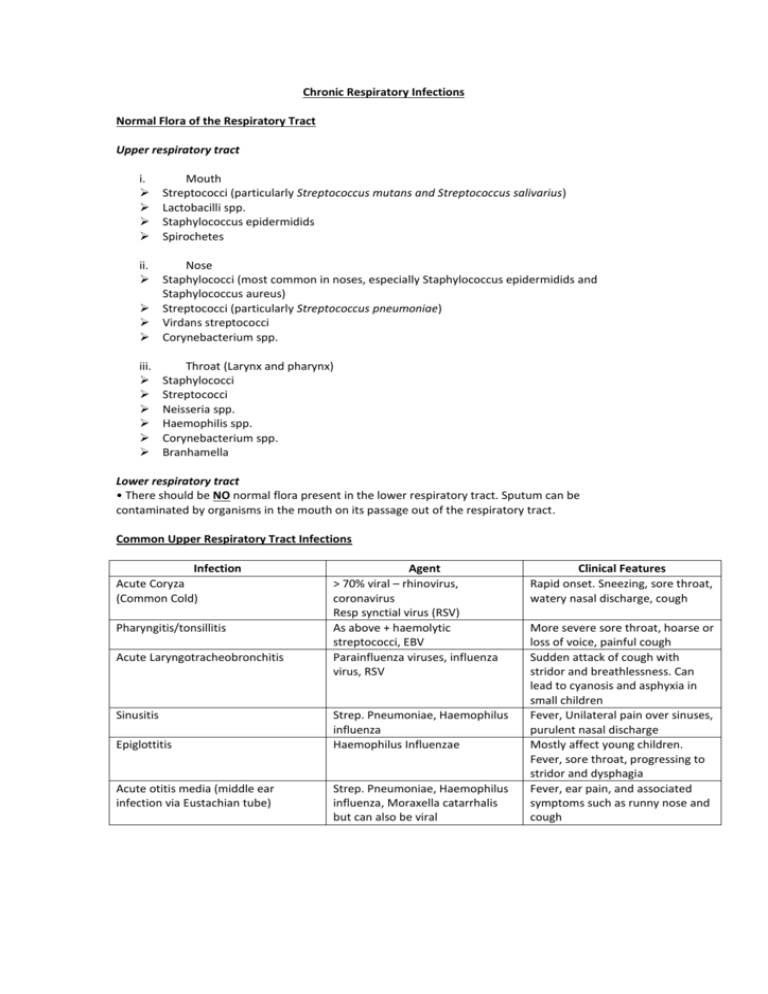
Chronic Respiratory Infections Normal Flora of the Respiratory Tract Upper respiratory tract i. Mouth Streptococci (particularly Streptococcus mutans and Streptococcus salivarius) Lactobacilli spp. Staphylococcus epidermidids Spirochetes ii. Nose Staphylococci (most common in noses, especially Staphylococcus epidermidids and Staphylococcus aureus) Streptococci (particularly Streptococcus pneumoniae) Virdans streptococci Corynebacterium spp. iii. Throat (Larynx and pharynx) Staphylococci Streptococci Neisseria spp. Haemophilis spp. Corynebacterium spp. Branhamella Lower respiratory tract • There should be NO normal flora present in the lower respiratory tract. Sputum can be contaminated by organisms in the mouth on its passage out of the respiratory tract. Common Upper Respiratory Tract Infections Infection Acute Coryza (Common Cold) Pharyngitis/tonsillitis Acute Laryngotracheobronchitis Sinusitis Epiglottitis Acute otitis media (middle ear infection via Eustachian tube) Agent > 70% viral – rhinovirus, coronavirus Resp synctial virus (RSV) As above + haemolytic streptococci, EBV Parainfluenza viruses, influenza virus, RSV Strep. Pneumoniae, Haemophilus influenza Haemophilus Influenzae Strep. Pneumoniae, Haemophilus influenza, Moraxella catarrhalis but can also be viral Clinical Features Rapid onset. Sneezing, sore throat, watery nasal discharge, cough More severe sore throat, hoarse or loss of voice, painful cough Sudden attack of cough with stridor and breathlessness. Can lead to cyanosis and asphyxia in small children Fever, Unilateral pain over sinuses, purulent nasal discharge Mostly affect young children. Fever, sore throat, progressing to stridor and dysphagia Fever, ear pain, and associated symptoms such as runny nose and cough Common Lower Respiratory Tract Infections Infection Bronchiolitis (mainly affects babies and little children) Acute Bronchitis Agent RSV, parainfluenza virus, adenovirus Rhinovirus, adenovirus, influenza virus, RSV Whooping cough Bordetella pertussis Chronic bronchitis exacerbation Strep. Pneumoniae, Haemophilus influenza, Moraxella catarrhalis Acute typical pneumonia Strep. Pneumoniae, Haemophilus influenza, Moraxella catarrhalis, Staph. Aureus, Legionella + many others Atypical pneumonia Mycoplasma pneumoniae, Chlamydia pneumoniaeS Clinical Features Cough, runny nose, dyspnoea Often follows common cold. Initially dry, painful cough. Then chest tightness, wheeze and breathlessness. May have fever Features of the common cold but also persistent cough and sticky mucous develops in RT making breathing difficult When breathing suddenly becomes more difficult for a person with chronic bronchitis (due to narrowing or airway and secretion of large amounts of mucous) Fever, shivering, vomiting, breathlessness, cough (at start short, painful + dry but later accompanied by sputum), chest pain Symptoms much milder than acute typical pneumonia Planktonic vs Sessile Organism • Bacteria in the environment are described as planktonic or sessile • Planktonic organism = organisms (bacteria) that remain suspended (float) in a fluid environment They have surfaces that are hydrophilic (water loving), do not have a surrounding sugar coat, so are very susceptible to antibiotics They are also easily detected and dealt with by the host immune system • Sessile organisms = organisms bound within or to a surface structure More resistant to antibiotic action than planktonic organisms This is because sessile organisms firstly form colonies and due to higher numbers, those in the centre are less susceptible to being affected by antibiotics But the main reason for sessile organisms higher resistance is due to the biofilm produced by the organism, which protects them from antibiotic action. It is thought that the biofilm produces antibiotic-degrading enzymes and also has the ability to “pump” out antibacterial agents (from the biofilm) before they can have an effect on the bacteria itself

